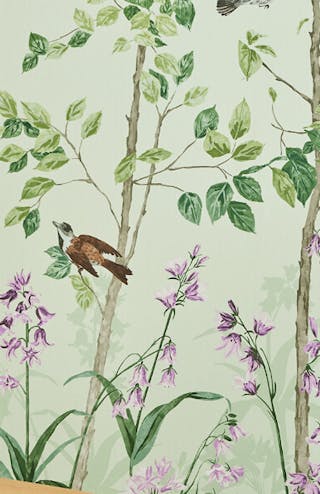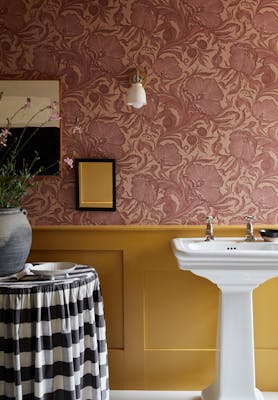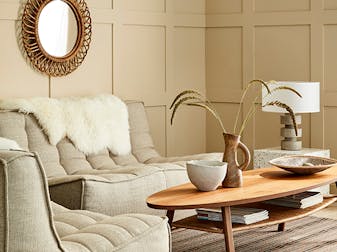
‘National Trust Papers III’ comprises 45 colourways representing over 200 years of decoration. Each design has been created from original source material found at three of the National Trust’s historic houses, Oxburgh Hall and Felbrigg Hall in Norfolk and Newark Park in Gloucestershire, with the addition of one design that has been recoloured and revived from the Little Greene archive.
Employing traditional methods of printing that have remained unchanged for over 100 years, the collection comprises an array of hand-painted birds, stylised florals and scrolling trails, as well as a traditional ‘Toile de Jouy’.
Bird & Bluebell (Felbrigg Hall) c.1830-1870
This elegant mural, (156cm x 325cm) featuring birds, bees and bluebells has been created from remaining fragments of wallpaper found at Felbrigg Hall in Norfolk. Originally on a striped background, the remaining source material has been adapted, transformed and recoloured to suit the contemporary interior. Available in four serene colourways including soft green, pink and blue, as well as a neutral.
Supplied in a standard 10m roll, there are three drops each 52cm wide and each 3.25m in height.
Volières (Oxburgh Hall) c.1950
A more contemporary find, this wallpaper featuring 1950s style doves, ribbons and flowers is a reimagination of an 18th-century design. Found at Oxburgh Hall, an archived photograph revealed the location of this wallpaper in one of the bedrooms in the private family quarters. The wallpaper is thought to have been a visible reminder of Oxburgh’s last days under family ownership, having been put up for sale just months after the wallpaper was produced. The soft pink original has been reproduced in Little Greene colours alongside four more contemporary colour combinations.
Poppy Trail (Felbrigg Hall) c.1890–1900
This flamboyant floral design featuring large, stylised poppies is a classic example of those in production during the late 19th century. Although the designer is unknown, it is thought that it may have been the work of Arthur L. Gwatkin who produced papers of a very similar feel.
This wallpaper was found on the walls of the corridor leading through to the top of the staircase at Felbrigg Hall, as well as a rolled sample in the attic stores.
Coloured in five tonal colourways, each with statement grounds.
Briar Rose (Oxburgh Hall) c.1845–1915
Characterised as being in the ‘Arts and Crafts’ style, evident in the densely stylised natural motifs, this wallpaper was originally designed by children’s book illustrator,
Walter Crane. Many of Crane’s drawings became nursery wallpapers and ‘Briar Rose’ began its life as the background to a wallpaper called ‘The Sleeping Beauty’, which featured characters from Sleeping Beauty among the roses. Found at Oxburgh Hall, little is known about where in the house the wallpaper was used, as much of the original exists today only
as loose samples. The paper was originally produced by the London firm Jeffrey & Co. and has been reproduced today in three gentle combinations and three vibrant colourways.
Upper Brook St. c.1920
This design features brightly coloured kniphofia flowers, commonly known as torch lilies or red hot pokers (African in origin but named after German horticulturalist Johan Hieronymous Kniphof). They were recorded as having been hand-painted and stuck over a pre-hung wall covering in a late 18th century Upper Brook Street house as a bespoke decoration. To replicate a natural scene behind the pokers, Little Greene has adapted a motif from its Stag Toile paper. Supplied in a standard 10m roll, there are three drops each 52cm wide and each 3.25m in height. The pokers repeat every drop but the full background scene is only completed when all three drops are hung.
Lovers’ Toile (Oxburgh Hall) c.1950
This contemporary take on a classic pattern is a post WWII reinterpretation of an 18th-century French Toile de Jouy design. Featuring vignettes of people in activity including fishing, dancing and gardening, this single colour design has been printed in five modern colourways. Reflective of colour drenching, two of the colourways feature the same colours in different tones.
Dahlia Scroll (Newark Park) c.1890–1900
A scrolling floral design reminiscent of the early work of Voysey. Found at Newark Park, this two-toned wallpaper features an enlarged Dahlia, a motif typically found in Japanese design, whilst the sinuous plant forms based on a single flower are also characteristic of Art Nouveau.
Coloured in seven different ways, including elegant neutrals, bold blue and vibrant yellow, this pattern would have originally been block printed possibly by Jeffrey & Co.
Hoja (Oxburgh Hall) c.Late 1890s–1900
Used to decorate one of the attic stores at Oxburgh Hall, this classic pattern featuring scrolling foliage has been surface printed to achieve a traditional, painterly finish. Although the design features elements from 17th century Spanish embossed and gilded leather, it is actually thought to have been of late 19th century origin due to its print substrate being machine printed paper. Created in six interesting colourways, four of which have tonal variation based around a single colour.
Poppy Trail - Masquerade Bathroom

‘The contributions made from the sale of every roll of National Trust wallpaper and each tin of paint goes towards supporting the National Trust’s conservation work, to ensure the nation’s historic houses, gardens and landscapes can be enjoyed for years to come.’Learn more about our partnership with the National Trust

Colours of England















































